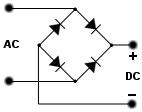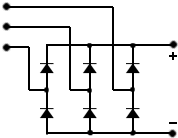|
|
|
|
 Print Print
|
|
|
| Understanding rectifiers. |
|
Rectifiers ( also called Diodes ) will only allow current to flow in one direction, we use rectifiers to convert AC ( Alternating Current ) into DC ( Direct Current ).
Symbol 
 One end of the rectifier is called the Anode(A), and the other is the Cathode (K). Current will flow from the Anode to the Cathode, but not the other way. One end of the rectifier is called the Anode(A), and the other is the Cathode (K). Current will flow from the Anode to the Cathode, but not the other way.
Most rectifiers have a mark to indicate the cathode.  |
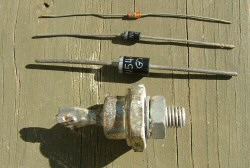 |
Half Wave Rectifier.
Uses a single diode, only half of the potential power is converted to DC. Generally not used unless your just doing some simple tests.
|
|
|
 |
| |
|
|
Full Wave Rectifier, Single Phase.
Uses 4 diodes to rectify both the negative and positive sides of the AC cycle. Almost all electronic appliances that use grid power have a Full Wave Rectifier, including your PC. |
|
|
 |
| |
|
|
Full Wave Rectifier, 3 Phase.
Uses 6 diodes to rectifier all 3 phases, both negative and positive sides of each phase. As you can see by the DC output, its a very smooth output compared to a full or half wave single phase rectifier.
|
|
|
 |
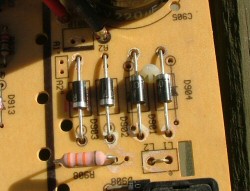 |
A full wave rectifier is also called a Bridge Rectifier. Bridge rectifiers can be made from individual diodes(left), or as a manufactured unit(right, hiding behine the big capacitor), where the diodes are sealed in a case. |
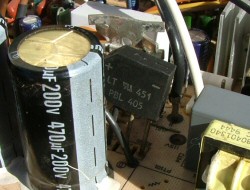 |
|
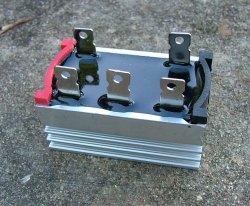 |
3 Phase bridge rectifiers are less common, you wont find them at your average hobbyist electronics shop, but they can be bought from larger electronics outlets like Farnell or RS Components. You can also find them on e-bay.
Most of our wind turbines generate 3 phase AC, so we need a 3 phase AC bridge rectifier. |
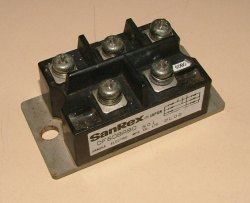 |
|
 Another source of 3 phase rectifiers are vehicle alternators. If you have a old car alternator lying around, maybe it has seized bearings or a dead regulator, chances are the rectifier is still ok so it could be worth checking it out. The diodes used in vehicle alternators are pretty tough, they can handle 50 or more amps, but the maximum reverse voltage might only be 60 or so volts. This means if you get a run away windmill, where its output voltage goes over 60 volts, it could blow the rectifier. Another source of 3 phase rectifiers are vehicle alternators. If you have a old car alternator lying around, maybe it has seized bearings or a dead regulator, chances are the rectifier is still ok so it could be worth checking it out. The diodes used in vehicle alternators are pretty tough, they can handle 50 or more amps, but the maximum reverse voltage might only be 60 or so volts. This means if you get a run away windmill, where its output voltage goes over 60 volts, it could blow the rectifier.
But other than that, these rectifiers will work perfectly well, I used one ( shown to the right ) on a windmill for many years and never had a problem with it. To find out more about using the rectifier from a vehicle alternator, see this page here. |
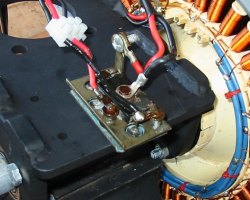 |
You can make your own 3 phase bridge rectifier using single phase bridge rectifiers. The circuit below uses 2 bridge rectifiers, you'll notice we only use half of one bridge rectifier.
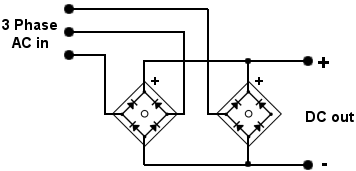
Or you can use 3 bridge rectifiers as shown below. This will give a slightly better current capacity and better heat dissipation.
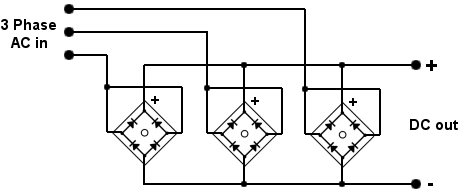
|
|
The 3504 single phase bridge rectifier.
 Most electronics parts outlets will stock a KBPC3504 rectifier, sometimes called a 35amp bridge rectifier. They are cheap at less than $4 each, and tough, with a 400v 35amp rating, very good value for money. You can use spade terminals or solder directly to the pins. I always keep a few 3504's spare. Most electronics parts outlets will stock a KBPC3504 rectifier, sometimes called a 35amp bridge rectifier. They are cheap at less than $4 each, and tough, with a 400v 35amp rating, very good value for money. You can use spade terminals or solder directly to the pins. I always keep a few 3504's spare.
KBPC3504 Datasheed here. |
 |
|
|
|
|
|
© TheBackShed 2011
|




